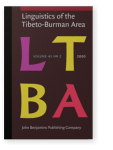Vol. 43:2 (2020) ► pp.310–347
The segmental phonetics and phonology of Hyow, A Tibeto-Burman language of Bangladesh
This paper presents a description and analysis of segmental phonetics and phonology of Hyow, a Tibeto-Burman language spoken by almost 4,000 people in the southeast of Bangladesh. Hyow demonstrates phonological features which are absent in other Chin languages of the Tibeto-Burman branch. Proto Kuki-Chin initial voiceless nasals are not only preserved in Mara and Central Chin languages (Van Bik 2009: 220), but also in Hyow. Unlike other Southern Chin languages, Hyow final liquids are sometimes preserved or developed into central approximants. In fact, final liquids are preserved in Bangladesh Hyow, and in two varieties of Laitu – Keyni and Myebon – and Laisaw in the Rakhine State of Myanmar. The salient and prevalent phonological process of re-syllabification in Hyow demonstrates that the glottal stop cannot be treated as a phonetic property of the coda-cluster sonorants, which is otherwise treated as glottalized in some Chin languages by scholars, e.g. Hakha Lai (Hyman & Van Bik 2002: 114). Hyow does not show a phonemic contrast between long and short vowels which is very often found in Chin languages. Though Mainland Southeast Asian Languages are profoundly known for having sesquisyllables or reduced syllables, in Hyow, vowels of initial syllables of disyllabic words carrying grammatical morphemes are harmonized with vowels of root-initial syllables, which confirms the absence of such type of reduced syllables in Hyow. The phonological description and analysis in this paper are furthermore supported by phonetic data and illustrations. Discussions of variant phonetic realizations of certain segments have also been included.
Article outline
- 1.Introduction
- 2.Syllable structure
- 2.1Phonotactics
- 3.Consonants
- 3.1Articulatory features
- 3.1.1Stops
- 3.1.2Affricate
- 3.1.3Fricatives
- 3.1.4Nasals
- 3.1.5Allophones of consonant phonemes
- 3.1.6Approximants
- 3.1.7Free variation
- 3.1.7.1Post-alveolar fricative
- 3.1.7.2Alveolar stops
- 3.1.7.3Palatal approximant
- 3.2Acoustic analysis
- 3.2.1The process of measuring VOT
- 3.2.1.1Correlations of acoustic and articulatory analysis
- 3.2.2VOT of the affricate
- 3.2.2.1Duration of voiced and voiceless sonorants
- 3.2.1The process of measuring VOT
- 3.1Articulatory features
- 4.Vowels
- 4.1Articulatory features of vowels
- 4.2Allophones of vowel phonemes
- 4.3Acoustic analysis of vowels
- 4.3.1Process of sampling
- 4.3.2Vowel space
- 5.Phonological processes
- 5.1Vowel harmony
- 5.2Resyllabification
- 5.3Glottal stop deletion
- 5.4Transphonologization
- 6.Conclusion
- Acknowledgements
- Notes
- Abbreviations
-
References
